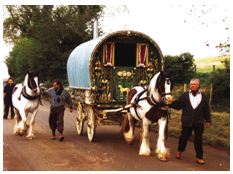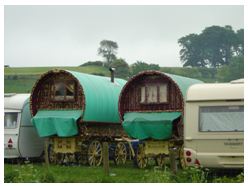Background History
The first Gypsies were Travellers or Nomads, who originated in India over 1,000 years ago. They are a distinctive group of people whose origins lie in nomadic tribes, and have been part of the culture of the world for centuries. Historical records show that they arrived in Europe in the 16th century, where they were first given the name of Gypsy. Not all Travellers are Romanies, and not all Romanies are nomadic. “Traveller” is used as a generic term, although Romanies generally prefer to be known as Gypsies. Each group has a different history and to a considerable extent, different customs and traditions. The cultural identity of all groups is based upon self-employment, self – help and Nomadism, (Okely, 1983,p10) while persecution and discrimination have been a consistent theme for them all. (Liegeois, 1986, p 46)
History shows that through the Middle Ages the original Romanies travelled from India into the Middle East to Egypt eventually arriving in Europe where they first became known as Gypsies. It is from India that they are thought to have learnt their knowledge of astrology, palmistry, fortune telling and sleight of hand. It is thought that they left India between 1000 - 1200AD, and possibly didn’t arrive in Europe until 100 years later. There are similarities between the Gypsy language and Hindustani which confirms the fact that they originated in India. They didn’t reach England until the 15th Century. (Romani Life and Customs, (1990), Grey Network: Bournemouth. The first records of their presence in Britain are in 1505 in Scotland. The first authenticated record in England was in 1514. (Smith, 2000.)
It has been suggested that they left India because they were in religious conflict with the Hindus and this could borne out by their diet at that time as it was known that Gypsies will eat animals that have died of natural causes - all of which is forbidden by the Hindus. It is thought that they left India between 1000 – 1200AD, but possibly didn’t arrive in Europe for another 100 years or so, not reaching England until the 15th Century. As they passed through Europe it is said that they claimed to be repentant Christians on a pilgrimage to Rome, and had taken a vow not to sleep in a bed for seven years. In this way, they aroused the sympathy of the local people and explained their need to beg for food and money. In those days, most people were impressed by foreign travellers, and therefore the Gypsies were received kindly to start with. They were known as Gitanos in Spain, Bohemians in France, Zingari in Italy, Ciganyok in Hungary, and the Dutch called them Heydens – the translation of which means heathens. Other countries referred to them as Pharoahites.
Due to the hardship they suffered and the need for survival, they were very adept at telling stories and tales and enlisting help. Through this they were able to obtain documents granting them free passage, and letters of recommendation from various Kings of Europe, including James V of Scotland, and even the Pope. It is said that their leaders assumed titles and were known by such names as Duke Andrew of the Egyptians, or Count Michael of Little Egypt.
During the 16th Century, more and more Gypsies poured into Europe until eventually, laws were passed to repress and control them throughout Europe. Some of these laws were never enforced except in Spain, where the Gitanos were whipped, burnt or branded during a period of over 100 years. In England, some were deported to America and Jamaica, and as late as in Cromwell’s time, thirteen were hung in Suffolk.
In most parts of the world, Romani people have always been the subject of prejudice, discrimination and even genocidal persecution. They were subject to slavery in Eastern Europe and were amongst the first victims of West European racism from the foundation of nation-states in the sixteenth century, to the death camps of Nazi Germany. Life for Gypsy people before 1500 in Europe was hard as laws were passed to expel Gypsies from Spain and Switzerland. By 1650 most Gypsy people were slaves.
In England under Queen Elizabeth 1st Gypsies were expelled along with all freed black slaves. Laws were passed condemning all Gypsies to death. After 1780 anti-Gypsy legislation was repealed. Gypsy people became a useful source of cheap labour in the fields, both as blacksmiths and entertainers – thus surviving on the margins of society for centuries.
In addition to the approximately 6 million Jews who were the targets of a complete annihilation policy in the Nazi Holocaust were an estimated 5.5 million "enemies of the German State" who were murdered under equally inhumane circumstances -- criminals and a-socials, the insane, homosexuals, Jehovah's Witnesses, political criminals such as communists and socialists, and Gypsies.
Estimates of the number of Gypsies murdered run from a high of 500,000 to 600,000 (Jan Yoors, 1971:34) to a more conservative figure of 200,000 (Martin Gilbert, 1981). However, some believe that figure may be as high as 1.5 million.
“Few groups of people suffer the universal fear and loathing experienced by Gypsies and Travellers, known in mainland Europe as Roma. Their persecution throughout history has been extreme and relenting. Pogroms (Genocide – by the majority against a defenceless minority group), expulsions, enslavement, ghetto-isation and discriminatory laws have plagued their existence. At least 500.000 Gypsies were murdered in the Nazi holocaust, and some believe the figure may be as high as 1.5 million. This has never impacted on the social conscience: wherever they go, there is hatred and distrust in the hearts and minds of non Gypsies” (Times Educational supplement, March 2004 )
In 1989, The Race Relations Act saw that Romani Gypsies were at last confirmed as an ethnic group. However, true Romani connections may have to be established in order to prove a case of discrimination. This legislation means that it is now a criminal offence to discriminate against those of Gypsy origin on account of their race.
After the industrial revolution and the mechanisation of farming the lifestyles of Gypsies changed drastically as they were no longer wanted for hop or strawberry picking and other traditional trades. Once again Gypsies had to adapt and found finding work difficult whilst the motorisation of families changed travel patterns.
The changes in society were also reflected in the Roma population. Many Gypsies moved from rural areas to cities and towns. Over the recent decades the material well-being of some travellers has improved; however there are still a range of issues that have been identified and continued to need addressing such as health, housing, education and discrimination. (A Better Road, (2004), Derbyshire Gypsy Liaison Group. Verbal source & Smith, 2000) In a recent representative poll conducted by MORI in England, more than one-third of those adults who took part admitted to being personally prejudiced against Gypsies and Travellers. This was greater than the levels of prejudice reported towards lesbians and gay men, other ethnic minorities and people with disabilities (Stonewall, 2005)
Gypsy populations present a whole spectrum of situations, from the family that roams across Europe in long wide caravans drawn by the most powerful cars, to the family mired in a shanty town, with no ever hope of getting out. (Liegious, 1986, p51)
One of the most enduring icons of Gypsy Traveller culture is the brightly painted and ornately decorated caravan or Vardo. In reality, however, the wagon was actually only in use for about 100 years, with the most ornate ones being mainly used by showmen. Throughout most of the nineteenth century and into the twentieth century, Gypsy Travellers travelled in light carts or on foot, using bender tents to sleep in. These were made of bent hazel branches which them supported a tarpaulin cover. The arrival of motorised vehicles from the early twentieth century meant that Gypsy/Travellers began to swap their horse drawn wagons for a caravan or trailer.
Almost every county in England has at least one “Gypsy Lane” or “Gipsy Road” which clearly
reflects the strong presence of Gypsies in England over many centuries
Source: The Living
Album, Hampshire County Council. 2003
- Log in to post comments




